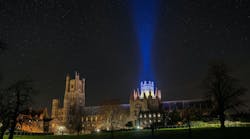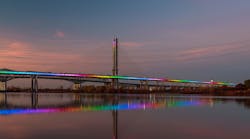The lighting design of the Kungsträdgården in Stockholm, by Light Bureau, represents a break from the past when it comes to illuminating iconic and historical areas. Taking home a 2021 IALD Award of Excellence, its design highlights the cultural and historical value of one of the oldest remaining public parks in the Swedish capital. The former lighting consisted of round-emitting diffuse globes mounted on poles along the park’s alleys of cherry trees and used unshielded metal halide luminaires, creating glare and causing light pollution.
The new lanterns are a contemporary interpretation of a historical park luminaire. Made up of two concentric cylinders in copper finish, the inner cylinder is illuminated by an uplight module with a warm light source and is switched on during the early evening, giving the lanterns a visual presence during the last moments of daylight. The primary light source, providing general lighting to the pathways as well as the tree canopies, slowly brightens over the following 30 minutes. This gradual lighting intertwines the electric and natural light with the Nordic characteristics of a soft bridge from light to dark.
By using efficient LED light sources, the total number of light fittings was reduced, resulting in a 50% reduction in overall energy consumption. Designers worked closely with the client from concept to commissioning. The finalized project is a timeless interpretation of heritage lighting in a prestigious environment.
This article appeared in the March 2022 issue of Architectural SSL magazine.






